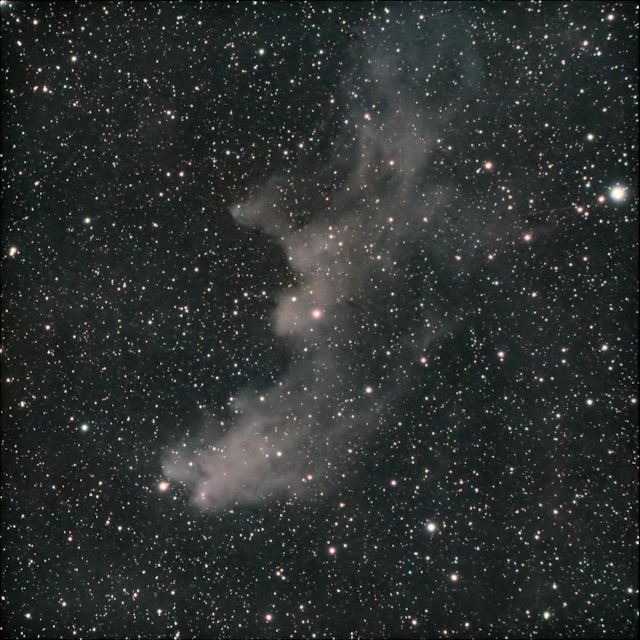Working with OSC filters and advanced functionality AstroDMx Capture
These imaging experiments were done with no Moon in the sky.
Experiments with Astronomik UHC-E or Optalong LeNhance filters with an SVBONY SV605CC OSC 14bit cooled camera and an ALTAIR STARWAVE 60 ED Imaging Refractor with an 0.8 reducer/flattener at f/4.8, mounted on a Celestron AVX mount controlled by AstroDMx Capture for Linux via an INDI server running on a Raspberry Pi.
AstroDMx Capture was used to capture FITS images.
As usual, the mount was placed on marks on the concrete base which give a fairly good polar alignment. AstroDMx Capture passed the time, altitude and location coordinates to the hand controller via the INDI server. The hand controller which now contained all of the correct information was set to its previous alignment and was unparked by AstroDMx Capture.
Astronomik UHC-E OSC filter
The Witchhead nebula NGC 1909
AstroDMx Capture was used to send the scope/mount to a bright star to check focus with a Bahtinov mask.
Then AstroDMx Capture sent the scope/mount to the mag 8.15 star HD32841, which lies roughly central within the Witchead nebulosity. This is a preferred way to compose the image, as sending the scope/mount to the published coordinates of the Witchhead nebula actually places the nebulosity off to the side of the field of view. HD32841 is the star that is in the middle of the final image. AstroDMx Capture plate-solved the field of view and centred the selected star
15 x 5min exposures were captured of the Witchhead nebula.
The Witchhead nebula is a low contrast object but was just visible in the preview window.
The data were stacked and partly processed in Siril and post processed in the Gimp 2.10 and Neat image. Star removal and replacement techniques were used to facilitate noise reduction and slightly reduce the saturation and prominence of the stars.
The Witchhead nebula NGC 1909 rotated into a more familiar position
Optalong LeNhance narrowband OSC filter
The Seagull nebula IC2177
AstroDMx Capture sent the scope/mount to the mag 6.5 star HIP34234, which is central to the nebulosity and is the star in the middle of the final image. AstroDMx Capture plate-solved the field of view and centred the selected star.
12 x 5min exposures were captured of the Seagull nebula
1h 15min of 5min exposures of the Spaghetti nebula on the East of the Meridian, plus 1h 20min of 10min exposures on the West of the meridian after a meridian flip. Giving a total of 2h 35min of exposures. Captured with AstroDMx Capture for Linux, an SVBONY SV605CC OSC 14bit cooled camera and an ALTAIR STARWAVE 60 ED Imaging Refractor with an 0.8 reducer/flattener at f/4.8 with an Optalong LeNhance filter.
The data were stacked and partly processed in Siril and post processed in the Gimp 2.10 and Neat image. Star removal and replacement techniques were used to facilitate noise reduction and slightly reduce the saturation and prominence of the stars.
The Seagull nebula IC2177
The Spaghetti nebula SH 2-240
This experiment involved combining 1h 15min of 5min exposures of part of the Spaghetti nebula when on the East of the meridian, plus 1h 20min of 10min exposures on the West of the meridian after a meridian flip. Giving a total of 2h 35min of exposures.
AstroDMx Capture sent the scope/mount to the mag 8.3 star HD 37537 which is located close to a loop of nebulosity in an interesting part of the nebula. This is the star in the centre of the final image.
The two sets of images were independently stacked in ASTAP. One of the stacked FITS images was flipped and flopped and then the two Stacked FITS images were registered, stacked and part processed in Deep Sky Stacker.
The image was post processed in the Gimp 2.10 and Neat image. Star removal and replacement techniques were used to facilitate noise reduction and slightly reduce the saturation and prominence of the stars.
Combination of 2h 35min of exposure on the Spaghetti nebula
These experiments were concerned with testing the two filters with the SV605CC and the ALTAIR STARWAVE 60 ED Imaging Refractor with an 0.8 reducer/flattener at f/4.8.
These imaging sessions were part of the testing of the advanced functionality in AstroDMx Capture. The software appears to be stable and all known bugs have been dealt with.
Nicola is currently implementing an improved preview stretching control and we anticipate that a new release of AstroDMx Capture for all operating systems will take place within the next couple of weeks.
The new version of AstroDMx Capture will have support for the prototype SVBONY SV605MC monochrome, 14 bit, cooled CMOS camera.







